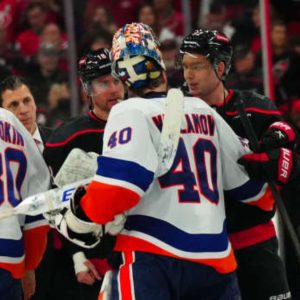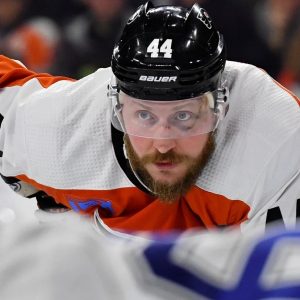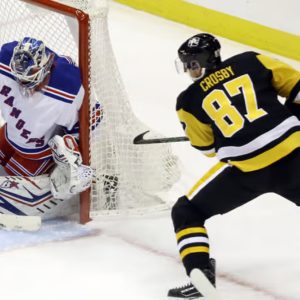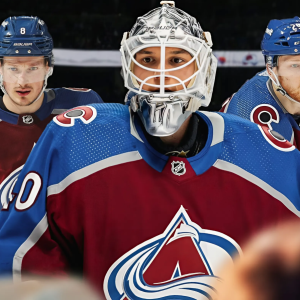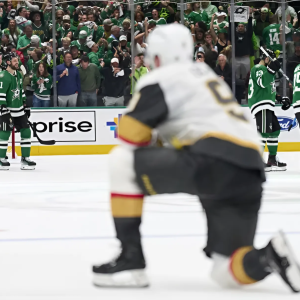It’s hard to take a lot of meaning out of summer hockey, but Friday afternoon’s World Junior Summer Showcase game between Canada and Finland came with extra juice for defenseman Andrew Gibson.
Just over a month ago, the Detroit Red Wings traded Gibson to the Nashville Predators in exchange for forward Jesse Kiiskinen and a second round pick. In Friday’s game, Gibson played against Kiiskinen, who is the captain of Team Finland.
“Obviously I want to prove to Nashville that I was worth that much,” Gibson said. “Playing against him, it makes me want to work extra hard and play even harder against him specifically, and everyone else on that team as well.”

Mandatory Credit: David Reginek-USA TODAY Sports
The two crossed paths a few times in the game, particularly in front of the net. They also lined up across from each other on the outside of a few faceoffs. “I don’t know if he recognized me,” Gibson said, “but I just kind of looked at him and I was like, ‘Hey, it’s the guy that I got traded for.’ It’s pretty funny.”
Gibson left those exchanges on the winning end of an 8-6 game that would’ve been a blowout if not for a late push by Finland on the power play. He was on the ice for a couple goals against, including one power play goal that Kiiskinen assisted on.
Overall, there’s a lot to like in Gibson’s game. His shutdown style helps out his teammates. This role is probably Gibson’s best shot toward making Team Canada, a team full of stars that needs role players like him to tie everything together. The same goes for any NHL hopes, where his shutdown play is his strongest attribute. It’s the kind of functional role that makes an NHL pathway clear, and it’s why a team like Nashville was willing to trade for him and give up extra assets.
The trade itself surprised Gibson, he admits. He thought he was “safe” from such a shakeup. At 19, having just signed his entry-level contract with Detroit less than a year after they drafted him, Gibson thought there was no way they could trade him, and neither did his family. When Gibson got the trade call, he told his mom. She thought he was joking.
“Obviously at first I was devastated,” Gibson said. “Being right in my backyard, I was training there every single day and it was a great time being there with the staff, getting to know everyone, for them to get to see me all year round. But I’m very happy with being in Nashville as well.”
It’s fateful that Nashville ended up with Gibson, because that’s where Detroit drafted him to begin with. When the trade happened, he had to scramble to book flights for a return trip to attend development camp. He also had to overhaul his equipment, swapping some red and white elements for Nashville’s yellow and blue. Luckily, he can still use his red gloves and helmet as backups for next season with the OHL’s Soo Greyhounds, who rock a similar red and white colorway. The other stuff Gibson gave to his friends and family as souvenirs.
Whatever color his equipment, it’s only a matter of time before anything Gibson wears is riddled in the black smears of blocked shots. It’s a skill he takes a lot of pride in.
“You want to be relied on in the last minute of the game,” Gibson explained. “If you’re up one and you’re that guy who’s gonna put your face in front of a puck for (your team) — for a win — they’re gonna put you out on the ice. And I pride myself on being able to do that.”
His teams appreciate it too. Take it from his goaltender with the Greyhounds, Landon Miller, who Detroit picked in the fourth round of the 2024 NHL Draft.
“He’s a great guy to be a teammate with, especially as a goalie,” Miller said June 29 at the draft. “He’s a great defenseman, a great shot blocker,” They’ve been friends and teammates for years with both the Soo Greyhounds and their Junior A affiliate, the Soo Thunderbirds. Miller elaborated that Gibson’s shot-blocking has as much of a mental effect on a goalie’s confidence as it does a physical one of one less shot to save. “Sacrifice from them, it means everything for a goalie, especially on the penalty kill and things like that. It’s exciting to see when guys are laying their body out for you.”
If Gibson’s hockey career had played out a little differently, perhaps he might be in the net himself. “I was probably the best road hockey goalie on the street, but I played one game and I let in 10,” Gibson joked. “But we won 11-10, so I’m 1-0.” But Gibson’s willingness to stop pucks didn’t immediately translate to being a shot-blocking defenseman.
“In minor hockey, I didn’t block one shot,” Gibson said. “I didn’t know how to do it. I was scared. I always did the flamingo. But about two years ago, my first year in the OHL, I realized I kind of gotta change my game. I’m the big guy who can play defensively and offensively, and to take my defensive game a step up, I needed to learn how to block shots.”
Technique came down to a lot of the same skills used as a goalie — for example reading a shooter’s stick, or timing when to move into a puck’s way. Gibson even takes notice of how opponents shoot, remembering their release so he can get the timing down to block them. Once Gibson got the hang of shot-blocking, it’s all he wanted to do.
Blocking shots like Gibson does has its costs, evidenced by all the extra padding he shoves in his equipment as shock absorption. No matter the technique or technology, blocking 80 mile-per-hour shots hurts.
It’s a cost Gibson is willing to pay, though, whether for the Greyhounds, Team Canada, or now, potentially with the Nashville Predators. In doing so, he hopes to prove to teams that he’s worth it.

